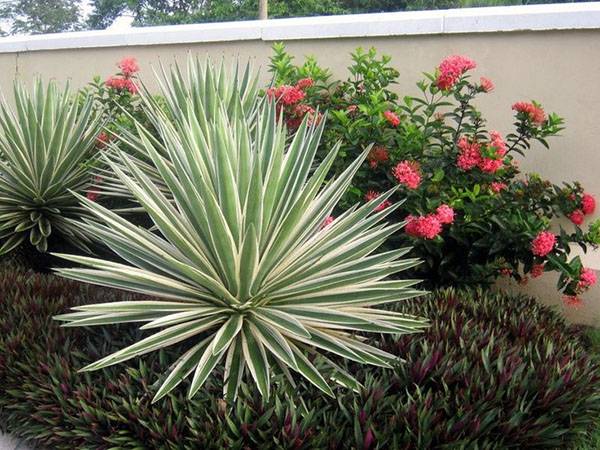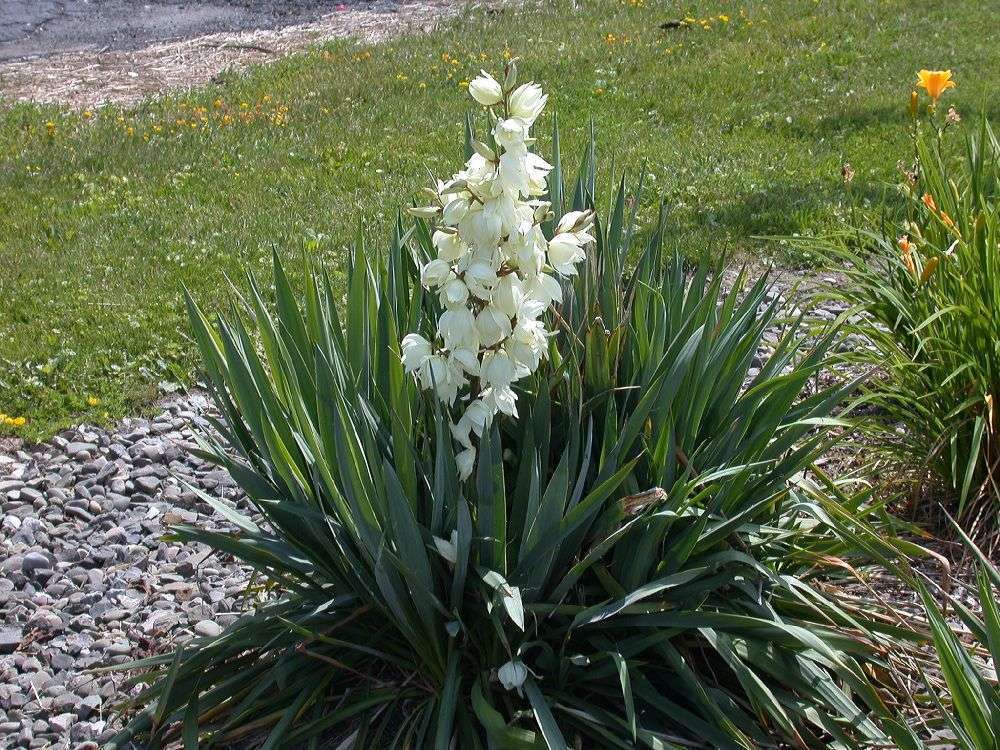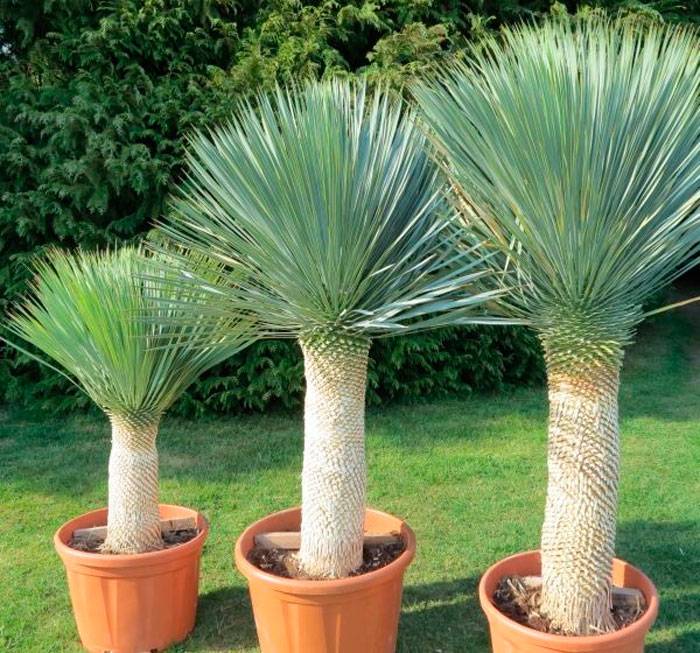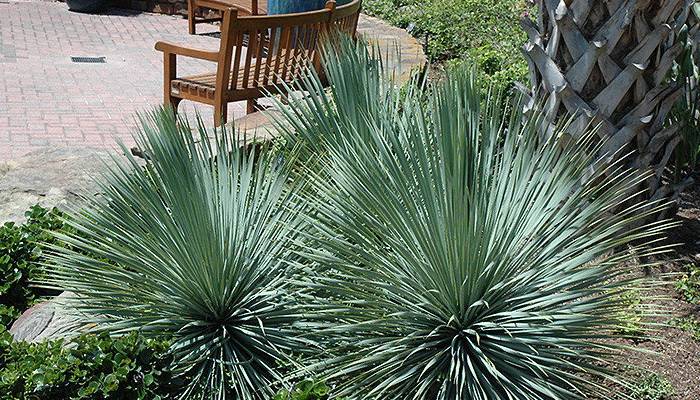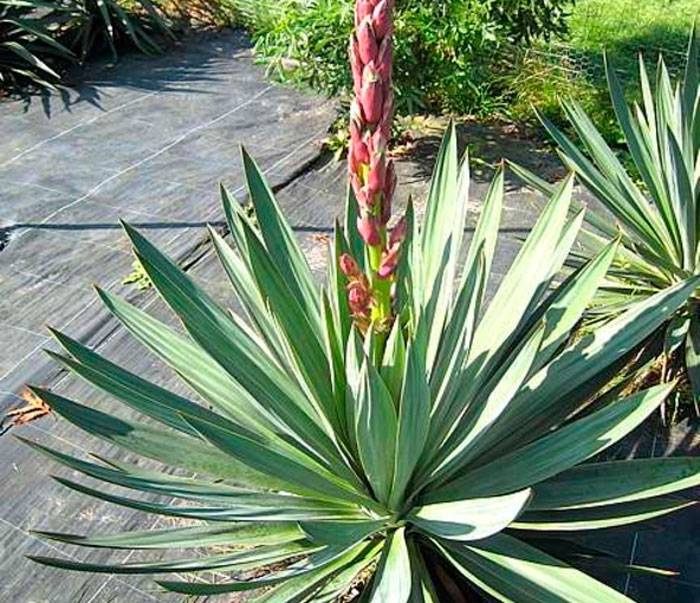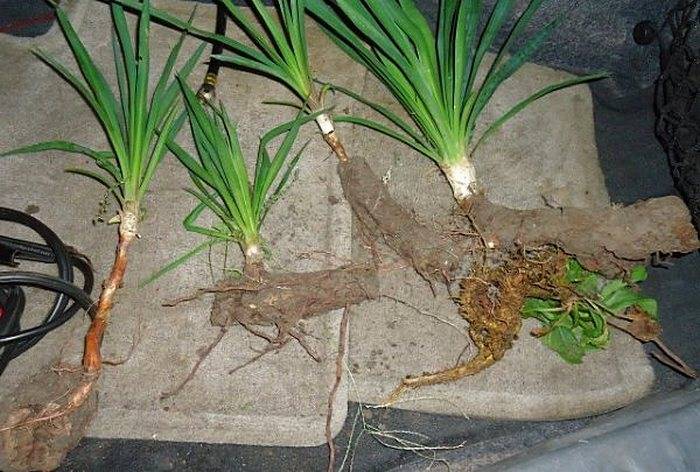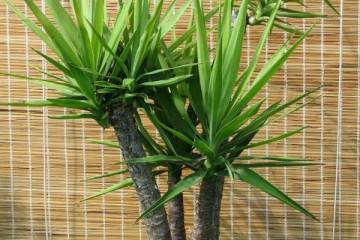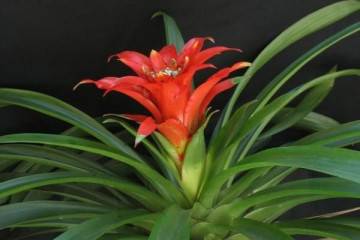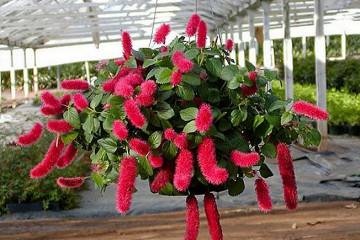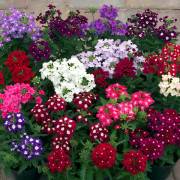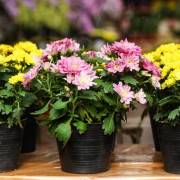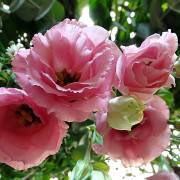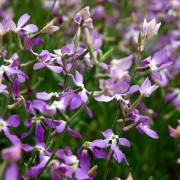Yucca flower - home care
Content:
Yucca is considered a fairly popular indoor plant, which is distinguished by its unpretentiousness and endurance. Quite often, the culture is grown as a standard tree. The perennial trunk is thick, with lanceolate leaves at its top. The information presented in the article will help you get acquainted with the peculiarities of caring for an ornamental culture.
Description
Yucca, which is easy to care for at home, belongs to the category of evergreen plants with a low stem. Depending on the variety, the tree may have little or no branching. In most exotic plant varieties, leaf plates rise above the surface of the soil. The foliage is arranged in a spiral. The length of erect leaves, endowed with a large size by nature, reaches 190-200 cm. They grow from the central part of the leaf rosette.
Varieties
Experts count about 40 types of yucca. Most varieties can only grow in natural conditions, since their height exceeds 600 cm. More compact species are used for indoor cultivation. Below you can find the most popular yucca varieties.
- The gray yucca is a kind of decorative culture, the height of which reaches 200 cm. The western coast of the United States is considered the homeland of the gray yucca. The length of the leaf blades is within 55-65 cm. The surface of the leaves is colored deep green with a bluish tint. The green mass is collected in bulk sockets. During flowering, the height of paniculate flowers reaches 80-100 cm.
- Yucca Rostrata is a beak-shaped variety, a distinctive feature of which is a thick stem. It is on the trunk of the tree that traces of foliage that have died out are clearly visible. At the top of the stem is a rosette, which consists of long foliage. The plant is recommended to grow only in large halls due to its large size. During flowering, an arrow forms, strewn with a huge number of bells, painted in white tones.
- Radiant filamentous yucca is an ornamental crop, the height of which can reach 700 cm. The leaf plates of plants of this variety taper towards the base. The green mass is located close to each other. The edges of the aloe-leaf green mass are covered with thin white threads that can look quite impressive.
- The Shidigera variety is a type of yucca that is distinguished by the formation of large rosettes into which leaf plates are collected. During flowering, a large number of white bells appear on the plant, which are located in the area of a powerful shoot-peduncle. Yucca Shidigera flower is often used by pharmacists for the preparation of medicines. The beneficial elements contained in the composition have a positive effect on the work of the gastrointestinal tract.
- The short-leaved yucca is a gigantic species, like the elephant yucca. Arizona and southern California are considered the homeland of the perennial. The maximum plant height can reach 900 cm. The diameter of the stem is in the range of 45-50 cm. The outer regions of the leaf plates are serrated. Closer to the top, the tree branches.This yucca plant can be grown in spacious rooms.
Features of yucca care
How to care for a yucca? By properly caring for a perennial, you can grow a healthy tree, which will systematically delight you with a gorgeous flowering. Yucca can beautify any interior. Below you can find the basic recommendations for caring for a perennial.
Temperature
Indoor Yucca prefers areas well-lit by the sun's rays. The room temperature should be between 24-26 ° C; in winter, the temperature regime can be reduced to 18 ° C. From October to the end of March, it is important to carry out supplementary lighting of the decorative culture. For this purpose, phytolamps can be used.
Lighting
Experts recommend placing yucca flower pots near windowsills on the south or west side. In the hot summer period, you can shade the plant. However, it is important to place the flower containers as far away from the heaters as possible.
How to water a yucca
The yucca palm needs moderate watering in the autumn-spring period. It is important to monitor the condition of the topsoil. If water accumulates on the pallet, it is necessary to take care of the timely draining of the liquid, which will make it possible to avoid rotting of the root system. During the hot summer months, the soil should be moistened every 2 days.
Air humidity
There is no need to spray the leaf plates of an exotic culture, but occasionally rinsing them with water from dust deposits is very important. The humidity indicator in the room in which the flower pots are located should be in the range of 40-50%.
Fertilizer
Ornamental culture needs systematic feeding (every 2-3 weeks). Experienced flower growers recommend using complex mineral fertilizers, leaf humus, horse manure or mullein infusion for this purpose.
Often, white streaks appear on the sheet plates from hard water. To prevent the occurrence of such a problem, the soil should be moistened with settled rain or boiled water.
The soil
For planting work, experienced florists recommend using slightly acidic soil. The earth must have good air and moisture permeability. This will make it possible to achieve full saturation of the root system.
For self-preparation of the soil mixture, you should mix a small percentage:
- leafy land;
- sod soil;
- coarse river sand;
- humus.
If desired, you can use purchased soil for planting, which is intended for planting dracaena, succulents and palm trees.
Features of winter care
If the decorative culture is in a too stuffy room during the cold season, its appearance undergoes changes, namely:
- leaf plates become thin;
- the green mass looks pale;
- a weakened flower is overcome by pests.
It is important to organize the correct temperature regime in the room in which the exotic culture is grown.
Bloom
How does yucca bloom? The most frequent flowering pleases the garden variety of yucca. However, with proper care, other varieties can please their owners with amazing flowers formed on a tree. Luxurious dark green leaf plates are characterized by increased density. Paniculate flowers are painted in white, red, pink or green-white tones.
Pruning
By systematically cutting off the upper part of the yucca, you can get a large number of formed lateral shoots. The procedure should be carried out at the end of March. Trimming is done with a sharp knife, which must first be disinfected. The resulting sections are sprinkled with a small amount of crushed charcoal or activated carbon. The cut off tip can be used for rooting.
Over the years, large palms develop thinner patches in the area of the lateral branches. Experts recommend leaving hemp when pruning shoots, from which young branches will subsequently appear.
Reproduction
To propagate indoor yucca, which is easy to take care of at home, can be done in several ways. The most effective methods are described below.
Seed method
Before starting to reproduce, damage the area of the hard shell of the seeds, which will speed up the germination process. To this end, it is necessary to file the seed skin using sandpaper. Scarified seed is sown in containers filled with a prepared soil mixture, consisting of:
- river sand;
- sheet soil;
- turf land.
The seeds are buried 20 mm into the ground. The container is covered with a piece of glass or foil. The container is transferred to a room with a temperature in the range of 27-30 ° C. The lighting in the pot area should be bright, but diffused.
The soil is abundantly moistened daily. The glass must be removed from the container every day for 10-15 minutes. for the purpose of airing. The first shoots should be expected 21-30 days after planting. After the second leaves begin to form on the seedlings, they should be cut into separate containers.
Cutting method
Florists recommend grafting during the spring months. Cuttings cut from the mother bush are dried throughout the day in a cool place. Almost all sheet plates are removed from the workpiece. The cuttings are planted in a container filled with perlite. Planting depth should be 25-35 mm. The rooting process usually lasts 21-30 days. All this time, it is important to systematically moisten the perlite, and place containers with cuttings in an area with diffused lighting.
Reproduction by part of the trunk
For reproduction by this method, you can use an adult yucca. The top of the tree is cut off with a sharp knife. The area of the cuts is powdered with crushed coal. The cut parts of the trunk are dried for 12-14 hours in a cool room. The blanks are rooted in a jar filled with boiled water. As soon as roots begin to appear on the branches, you can begin to transplant the yucca.
When the trunk is too large, it is necessary to cut it off and move the cuttings to a convenient container filled with wet sand (should be laid horizontally). Soon dormant buds will begin to wake up, which contributes to the formation of shoots with roots. Leaves and shoots will begin to appear on the stumps.
Transfer
As soon as the root system of the plant becomes cramped in the pot, you should start transplanting as soon as possible. It should be borne in mind that young palms need an annual transplant. For mature trees, the topsoil can be replaced.
Yucca home (Yucca) is difficult to tolerate transplants, which is why it is so important to carry out the procedure in the spring. The transplant is carried out by the transshipment method. The plant in this case is transplanted together with an earthen lump.A drainage layer is poured onto the bottom of the new container, which will make it possible to avoid stagnation of water in the root area. The soil mixture is poured over the drainage system. The root system of the plant along with a lump of earth is lowered into a depression dug in the ground. The resulting voids are filled with a layer of soil. The earth is compacted and moistened abundantly.
Diseases and pests
Pests such as spider mites, scale insects, aphids and thrips can harm yucca. Quite often, an invasion of insects occurs against the background of improper crop care. It is very important to follow the recommendations of experts and properly moisten the soil and apply top dressing. To cope with insects, it is recommended to spray the plants with insecticidal preparations.
Among the main diseases that most often affect perennials are:
- stem rot;
- root rot;
- bacterial rot;
- gray and brown spotting;
- bacterial burn.
What to do in case of infection of a flower and how to reanimate it? To cope with diseases, experts recommend treating with fungicidal agents. The most effective drugs in this category are oxych, vitaros and alirin-B.
Yucca is a decorative culture that, with proper care, can become a real decoration of any room. When growing a perennial, it is important to choose the most suitable watering regime and the frequency of feeding, which will allow you to grow a healthy plant that pleases with a gorgeous flowering.
